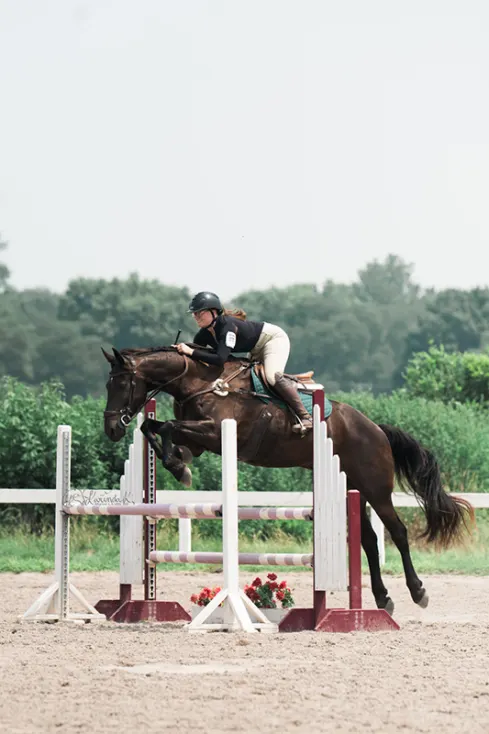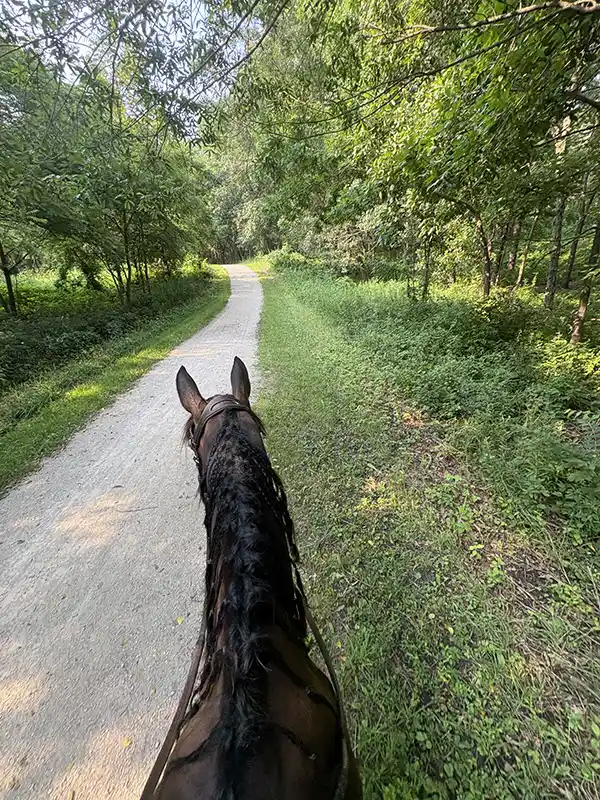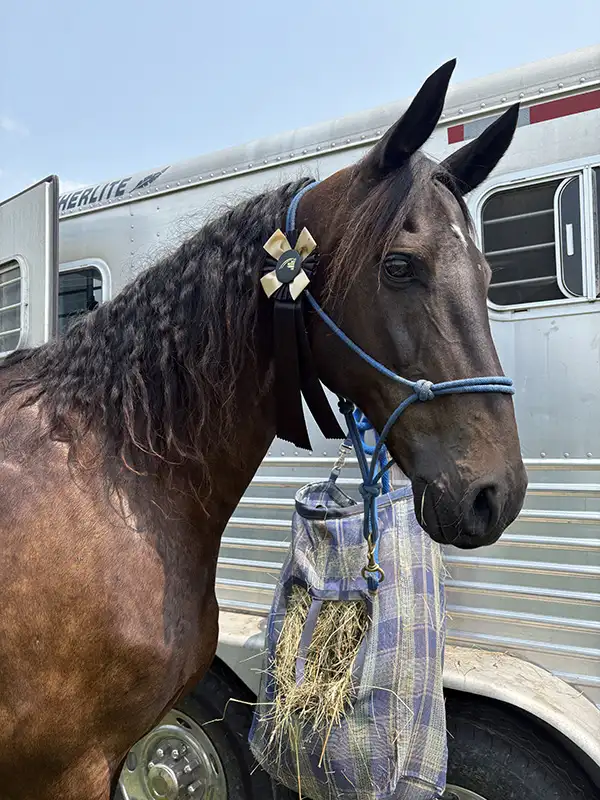Last time I wrote about horse showing, it was to say I was done trying to do it. I used to show at least three or four times a year, but I couldn’t afford it when I went back to school six years ago, and even once I was out and working again I couldn’t stomach spending a whole grand in one weekend to do a single jumper division. Before I rode at the United Dressage and Jumping Club’s Oaklawn Farm Show II, held Aug. 2-3 in Wayne, Illinois, I had not done a jumper show since 2019. While I still enjoy jumping at home, my plan until recently was to just enjoy my horse, go trail riding, and maybe do a little overnight camping with him.
Well, it turns out it’s a little harder than I thought to stay away from the sport that got me addicted to this lifelong horse habit in the first place. As time has passed, and I have moved out of school and into my career, now that I feel like I have a little more financial stability to spend money on extra things, I find myself absent-mindedly scrolling through lists of horse shows and horse trials in my area, thinking more and more about how it could be fun to go jump around somewhere other than my arena at home.
I board at a self-care facility and don’t have a trainer in Wisconsin, so I figured going to some sort of competition was a good way to check in and see whether the small amount of skill I have managed to acquire in my 31 years of life was being maintained to a reasonable, up-to-snuff standard—“snuff” in my mind meaning, “Can I jump around a three foot course without scaring anyone watching?”

Around that time is also when I started seeing these funny little videos come up on my Facebook feed. You’ve probably seen them too: They feature German rider David Reichert speaking to the camera about a new show series he has created called UDJC, the United Dressage and Jumping Club. Two lines in the video caught my attention in particular; the first was a claim that UDJC “offers recognized horse shows, with double the fun at a fraction of the cost, in the disciplines of dressage and jumping.”
That got me curious for a couple reasons. First of all, I found it interesting that the shows featured dressage and jumping classes. I learned after speaking to David at the Aug. 2 horse show that he very intentionally set it up this way. When David was growing up learning to ride in Germany, he said it was expected that riders learned both dressage and jumping.
“All of us were expected to do both until we could ride around a third level dressage test and a [1.20-, 1.25-meter] jumping course,” David explained. “Then we would start to specialize in one of the other.”
When David moved to Texas in 2020, he was surprised how separate the two sports were kept in the United States, and he felt it was to the detriment of developing riders’ skills. Combine that with the eye-popping invoices he was seeing people pay to compete in American horse shows, and David decided he needed to do something about it.
So, in January, he produced the first UDJC horse show in Texas, complete with very entertaining promotional videos like those I saw on Facebook. (Fans of funny horse people on the internet will know The German Riding Instructor; he’s David’s friend and inspired many of the UDJC videos.)
I understood the concept for the show, but I did still wonder just how fractional the prices of these shows really were. I did a Google search for UDJC shows in my area and then pulled up an entry form on HorseSpot.net. Sure enough, it was indeed fractional: The trailer-in fee would be $30, each class would cost $35, with anywhere from $100 to $250 dollars in prize money awarded even in 0.65-meter classes. I could also choose between a 30-day trial membership for myself and my horse ($10 for the horse, $30 for me), or I could get a lifetime membership for my horse for $175, and an annual membership for myself at $90. So far so good. These are the kind of prices I am looking to pay for a horse show.
ADVERTISEMENT
The second line in the video that I found interesting was David’s statement about how the jumper classes would be judged. He explained all classes under 1.0 meter would be judged for style not speed, “because no one should be racing through 70-centimeter courses with 14 jumps and two combinations against the clock.” The video explains riders are given a score, from 1-10, based on how well they rode the course, with 0.5 points deducted for each rail down.
I couldn’t agree more. We all know the scariest place at a horse show is the warm-up ring for the 0.85 class, and I have seen many a rider go into those classes and gallop around at breakneck speed, narrowly avoid flipping their horse over an oxer they left two strides too soon for, and be rewarded with a win if they managed to keep the fences up. I don’t want to fly around like a maniac, but when the fences are that low, if you are not willing to match these rider’s speed, you’re not competitive.
I’m glad some of the lower jumping classes at USEF-recognized shows have switched to an optimum-time format, because that definitely incentivizes better riding, but this UDJC concept of getting a score similar to an equitation class from a judge representing how well I rode the course was intriguing to me.
So I decided to take the leap and sign up for the nearest UDJC show to me, which was held at Oaklawn Farm in Wayne, Illinois, a few minutes down the road from HITS Chicago at the larger Lamplight Equestrian Center.
I still meant what I said a few years ago about wanting to continue trail riding and camping with my horse, so after looking up the address for the show, I started Googling to find the nearest campground that allowed horses. The answer was about 20 minutes away, at the Burnidge Forest Preserve. For $20 a night I could park my truck and trailer and camp with my horse. I had water, electric outlets, a fire pit, hitching posts, and nine miles of trails around the property to explore.

So, after working the full day the Friday before the show (all of the classes for the show were on Saturday and Sunday—bless up for the working amateur), I grabbed my dog and loaded the trailer at 6 p.m. to make the two-hour drive to the campground. I arrived a little after 8 p.m. and got my horse Moji set up in his spot; in an ideal world, I prefer to camp at sites with paddocks, but this one only had hitching posts where you could rig a tie line. Luckily Moji couldn’t care less, so I strung up the line, secured his rope halter to it with a safety knot, and he was good to go.
Let me say, I know what some of you may be thinking at this point: There is no way in hell my show jumper would tolerate camping overnight, tied to a line. I could have gotten a stall at the UDJC show for $100, but I both enjoy the camping experience and loved that this show gave me the ability to save money if I wanted to. With no requirement to stable on grounds, I could save money on both a hotel and a stall by camping.
This has always been my beef with horse shows: I can be frugal with where I keep my horse (self-care board), I can be frugal with how I take lessons and train my horse (haul in, look up exercises to do at home online), I can be frugal with where I sleep at night when I’m at a horse show (a mattress in the gooseneck trailer tack room). But I cannot do anything to lower the cost of entering a class, nor the cost of a membership fee, and many USEF-recognized shows either don’t allow haul-ins or charge so much for them that you may as well get a stall.
I have no problem with people wanting to horse show very differently than I do. You can get a stall and a grooming stall, stay in a nice hotel, board at a full-care facility, and pay a braider and a groom to get your horse ready, if you want. I have a problem with the cheapest option for a person willing to put in the work and do everything possible to make a show affordable still being a $1,000 horse show bill.
ADVERTISEMENT
So here was an option that gave me that freedom—and turned a horse show weekend into a two-for-one camping trail ride. UDJC uses HorseSpot.net as its show software, and the start times for classes are updated throughout the day. So when my Sunday class wasn’t scheduled to start until noon, I slept in, made some coffee, moseyed around the campsite with my dog, and then, while still wearing my oversized T-shirt and pajama pants, tacked up Moji for a walk around the trails to stretch his legs. Sure beats sitting on a trunk in front of my stall waiting for my class to start! Around 11:20 a.m, I loaded him to make the 15-minute drive from the campground to the show.

The show itself served exactly the purpose I needed it to, which is to say it was both fun and made it very apparent what I needed to go home and work on. Back in 2019 Moji and showed in the 1.0- and 1.05-meter adult jumpers, but since we were out of practice, I decided to do the 0.75- and 0.85-meter classes on the first day of the UDJC show, and the 0.85 and 0.95 the second day. USEF ‘r’ hunter and hunter seat equitation judge Kathy Davidson was judging our classes, and along with assigning a style score, judges at UDJC shows give immediate feedback to riders after their rounds.
So for each of our classes, Moji and I would finish our round, make a circle, and then walk over to the judge’s booth to get a quick lesson on what we did right, and what we needed to work on. As someone who doesn’t have a trainer at home—or at the show with me—this was so helpful.
Kathy commented on Moji’s big stride and how I needed to package him together more as the course went on and not let him get so strung out. She also suggested I work at home on jumping from deeper distances, because she could tell we both preferred the long distances, but we needed to have both options in our toolbox.

I remember interviewing Anne Kursinski back in my days as a full-time Chronicle reporter, and her saying that a horse show is supposed to be the test you take after sitting at home and doing your homework for a few weeks or months. Are the things you’re working on paying off, how does your riding stack up against your peers, and can you apply everything you’ve worked on at home in a new environment with some pressure?
From that perspective, my UDJC experience was the perfect horse show. Not only is it testing what you’ve been working on at home, you get graded by the teacher in real time and told how you did, and how you can improve! Getting a ribbon for not dying in the 0.65 class you chipped and flew around isn’t really testing your skills or making you a better rider. Being judged on your style and skills and only rewarded when you ride in a way that is safe and effective and kind to your horse makes a lot of sense to me, and it makes doing well in a class feel a lot more rewarding. I love that there is a place I can go and compete and be rewarded for riding well at lower heights, and I only have to spend a couple hundred bucks to do so. (Exactly $220, if we want to be precise.)
I am totally stoked that David has started these shows, and I can’t wait to hit up the next one in Illinois.
Ann Glavan is an associate attorney with LawtonCates S.C. in Madison, Wisconsin. Before becoming an attorney, Ann spent four years working full time for The Chronicle of the Horse.














